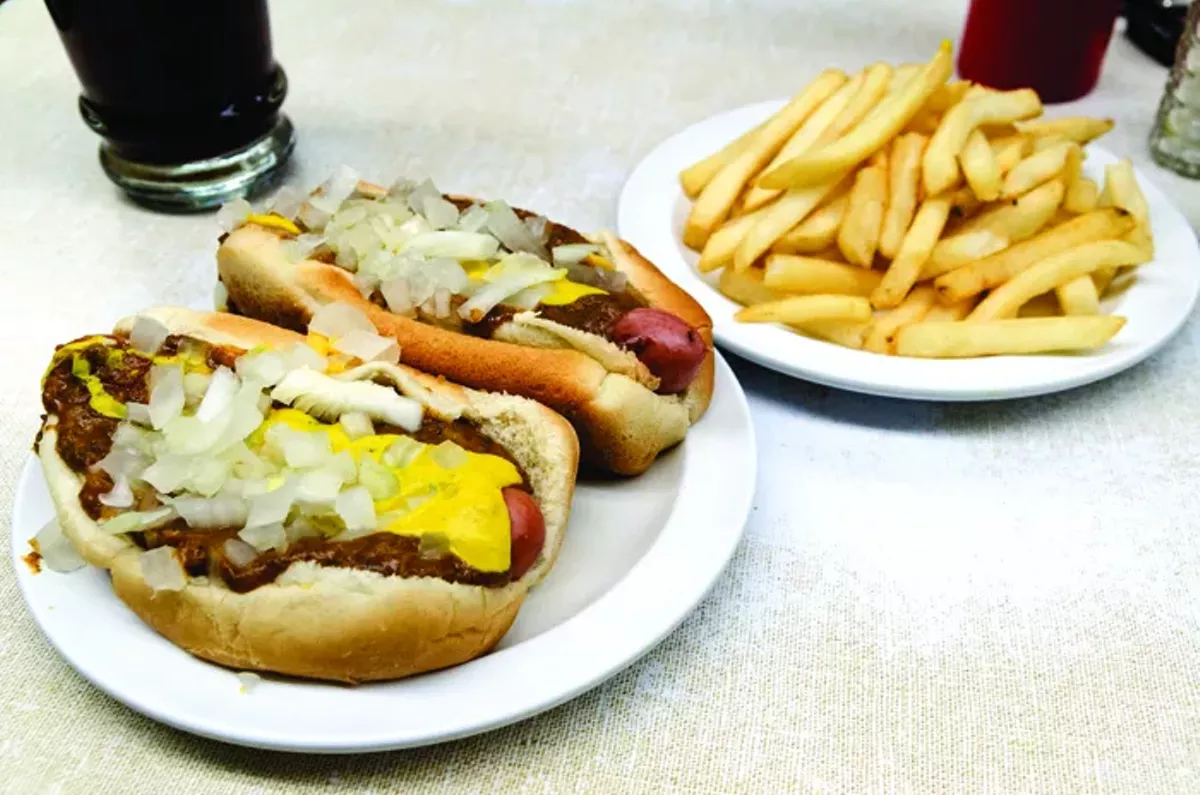A food business doesn't stay open in Detroit by phoning it in. To last through decades of boom and bust, growth and upheaval, eateries need something special, even if it's often just a gimmicky dish. It helps if it's something inexpensive and earthy, a comfort food or a quick snack that can draw a passionate allegiance of fans. (It's no secret that some Detroit's longest-lasting food businesses produce such things as soda pop, potato chips, doughnuts, burgers, and frankfurters.)
But, the funny thing is, people do get passionate about these creations. People who leave Detroit and can't get decent hash browns or almond boneless chicken begin to ache for these foods. Part of a visit home to the city often involves a stop at a beloved Coney Island or barbecue joint. What's more, new traditions are being born that fuse the past and present. Here's an overview of some high points, old and new.
American or Lafayette?
The humble centerpiece of Detroit food is the coney dog. Served at restaurants called "Coney Islands," it is a steamed bun containing an all-beef frank with a natural casing, covered with beef-heart chili, mustard, and chopped white onions.
Coney dogs debuted in Detroit in 1917, with the arrival of Gus Keros, who opened American Coney Island. He got into a dispute with his business partner, his brother, who opened Lafayette Coney Island next door in the 1920s.
Lots of people eat at both restaurants, but there are those who are loyal stalwarts either of American or Lafayette. It's probably not an overstatement to say that preference for one or the other can sometimes make or break a friendship.
American has a lot going for it. It has a third-generation spokesperson in the lively Grace Keros. It has its own chili provider, Detroit Chili Co. Their own proprietary hot dogs are made for them by Dearborn sausage company. American is brighter, more open, and airier, with red-white-and-blue designs accenting the interior.
Lafayette would seem to have less going for it. It is not family-owned anymore. A trip to the bathroom requires an unusual journey down some ancient stairs into the bowels of the building. And the cooks and waitstaff, always within earshot, have a way of shouting out orders and clanging pots and pans and clattering dishes together that creates a lively din. And this is precisely the quality that Lafayette fans seem to prefer.
In the end, what you get on the plate is very similar. Everybody's a winner. In fact, both diners probably profit from the ancient rivalry.
The 'real' Detroit-style pizza
When it comes to our city's contribution to pizza pie, it's kind of the ultimate long, involved story.
Start with the pie. It's Sicilian style: rectangular. It often wears its sauce on top of its cheese. Some call it "deep dish," but it's nothing like the Chicago innovation.
It was first served at Buddy's in Detroit. Toward the end of Prohibition, Buddy's had been a little speakeasy at the corner of McNichols and Conant. After the booze ban was lifted, it stayed busy due to the crowding of wartime Detroit. But, after the war, the restaurant needed a little something to keep customers coming in. That innovation was Detroit-style pizza.
That's where the story gets complicated. As Buddy's was bought and sold and as its staff and owners left and opened other places, the pizza became more than one bar's specialty.
Buddy's founder Gus Guerra brought the pie to his new bar, Cloverleaf, in what is now Eastpointe. Louis Tourtois quit Buddy's and used the kitchen at Shield's to make pizza, and they wound up appropriating his recipe. In 1977, Tourois opened Loui's in Hazel Park, which also serves the pizza.
You can get this pizza with a pedigree at 19 different restaurants all over the metropolitan area. (Buddy's has 11 locations; Cloverleaf four; Shields three.) We'd single out the historic locations as special. The original Buddy's in Detroit is a few rooms, including a charming old bar that you step down into. But perhaps Loui's is the most unusual, a large place with empty chianti bottles on the walls, quirky decorations, and waitresses who call you "hon."
Why Tacos al pastor?
Travel through Southwest Detroit and you'll notice a definite Latino flavor. That's because the neighborhood has been a destination for Mexican immigrants for decades now. But you may not be aware that most of these folks emigrate from one place in particular: Jalisco, the state in western Mexico famous for its tacos al pastor. That's why you'll find the tasty delicacies known as tacos al pastor at taquerias up and down Vernor Highway. They're simple creations, but they take hours of preparation to do properly, with marinated pork, chopped white onions, cilantro, and a wedge of lime (and sometimes pineapple). They're practically the house specialty at Taqueria Lupita, Taqueria Nuestra Familia, Los Altos, and almost every single place in Southwest Detroit — at prices less than half of what you'd pay in the suburbs.
Almond Boneless Chicken
Like a lot of Chinese dishes available in this country, almond boneless chicken is not authentic Chinese fare. It's one of those hearty dishes that tweaks Cantonese fare for American tastes, and almost every Chinese food joint in town serves it. It's a fried, battered chicken breast cut into sections atop rice and lettuce, drizzled with gravy, slivered almonds, and chopped scallions. The breaded chicken is rich, and the gravy softens the breading somewhat. The way the dish is situated on a bed of chopped lettuce wilts the greens slightly, and when they mix with the gravy, rice, and almonds, the concoction becomes something sublime. It's a popular local comfort food so commonly ordered that die-hard Detroiters know it as ABC.
But it's only available here. Order it anywhere outside Detroit (and maybe Toledo), you'll get something completely different, often a soupy mess completely unlike this classic dish. All the more reason for those returning home to rediscover this authentic Detroit delicacy.
New vs. old-time barbecue
A million years ago, back in 2005, Slows Bar-B-Q opened on Michigan Avenue, heralding the arrival of barbecuism in Detroit. Since then, dozens of new barbecue restaurants have opened across the metro area. Many of them are great, not just producing hunks of meat cooked low and slow, but complementing them with first-class beer selections, and often doing it in spruced-up historic buildings.
But there's another class of Detroit barbecue that's often overlooked: It's the barbecue of black Detroit, with sizzling, down-home fare that traces its heritage directly to the old South. It's almost always take-out food, so you'll want to rush it home, or to find a bar that will let you bring your own carry-out. But what you'll find is a revelation of flavor.
Barbecue joints like Uptown BBQ, Nunn's, and Vicki's offer excellent ribs at affordable prices. Perhaps best are Vicki's, which come in hot and mild, the hot variety getting a generous shake of spices and an extra dollop of hot sauce. For something a little more offbeat, try Parks Old Style Bar-B-Q, which offers a signature vinegar-based Southern sauce. There are even unexpected treats available, such as a slice of the colorful "Kenta cake" from Nunn's.
Paczki vs. jelly doughnuts
Every February, the residents of Hamtramck gear up to celebrate Paczki Day, a sort of Polish-inflected Mardi Gras involving bar crawls, blackberry brandy, and a doughnut-like confection known as the paczek (PON-check). Since few people eat just one, they're usually referred to by their Polish plural, paczki (POON-shkee). They usually come a dozen to a box, looking very much like jelly-filled doughnuts.
But don't call them doughnuts. They're paczki. And paczki aren't doughnuts.
Unless they are: Some opine that real Polish paczki are richer, made of dough stuffed with all the lard and sugar in the pantry, since religious law forbade their consumption during the Lenten fasting season. That said, the American versions are super-sized compared to the ones you'll find in Poland. As with everything else, we make things bigger here.
The best "chicken & waffles"
If you weren't aware that chicken and waffles go together, you may want to explore this soul food dish a little more closely. It's very much what it sounds like: Breakfast waffles with butter and syrup and fried chicken. In 2012, Metro Times readers selected as best a souped-up version served at Fort Street Brewery in Lincoln Park, which heaps a crisp Belgian waffle with cheddar cheese, peppered bacon, a fried egg, and breaded chicken strips, with maple syrup on the side. Two years later, our readers shifted their allegiance to New Center Eatery, which bills itself as "Detroit's original home of chicken and waffles." Perhaps things have changed since, with the opening of Kuzzo's Chicken and Waffles on the Avenue of Fashion in northwest Detroit. Which is best? Ultimately, it's your call. But what a delightful research assignment that is.
What's a "deli slice"?
How do you keep people coming in the door when there are fewer of them out on the street every year? A gimmick is just the thing. That's one of the ways Dan & Vi's stays in business in Detroit's old Poletown neighborhood. The little deli and pizzeria run by the Skinner family is on an extremely depopulated stretch of Chene Street; in fact, it's the last building left standing on its block. But it's a hit at lunchtime. And almost everybody who comes in for lunch orders "the deli slice." It consists of ham, salami, cheese, shredded lettuce, chopped tomato and onion, with Italian dressing, layered between two pizza crusts seasoned with butter and Parmesan. It's basically a submarine sandwich that uses two pieces of pizza crust as its bread. Since the Skinners started selling it a decade ago, it has become a sensation.
Tofu as catfish
How does a newcomer to this dining landscape offer something you just can't find anywhere else? There are still a thousand tricks waiting to be tried out. At Detroit Vegan Soul, it's a fascinating challenge: What if you produced soul food that was vegan and healthful, with dishes that could be tweaked to cater to people's dietary restrictions?
That was the dare head cook and co-owner Erika Boyd set out to solve: How to take the culinary heritage of slavery, which relied heavily on animal products that can lend themselves to health problems, and transform it into a menu of healthful dishes that satisfied soul food's most ardent fans. It's expressed in such dishes as seitan pepper steak, organic greens enriched without fat, and a convincing tofu catfish. Perhaps it's just the kind of new classic to keep another Detroit restaurant lasting into the future.







